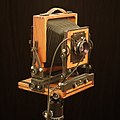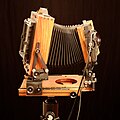Walking floor camera

Floor cameras are cameras with a front standard (frame with lens ) that can be moved on rails along an opened floor.
As a rule, they were amateur and press cameras , which were mainly used in the years 1910 to 1940, i. H. before the time of 35mm film. The most commonly used film format for running floor cameras is sheet film 4 "× 5" (10.16 cm × 12.7 cm).
A walking floor camera is about the size of a thick paperback when folded. From the vertical position (on a loop or, more rarely, on the shoulder strap), the front is folded down by 90 degrees, usually by pressing a release button and locking the floor on two hinge struts exactly in the 90-degree position. The lens and its standard holder can then be pushed out on the floor. The bellows unfolds. The sighting device , usually a small mirror with a magnifying glass , is usually located on the lens . The better walking floor cameras also allow the lens to be adjusted upwards out of the optical axis (“ shift ”) in order to keep the distortion of vertical lines in architectural photography small. Further adjustment options can be the pivoting and shifting of the objective standard or the film plane (e.g. Linhof Technika).
The advantage of this design is a compact and relatively light housing that offers good protection for bellows and mechanics and still has the adjustment options of a view camera.
Before the advent of the 135 format cameras , floor cameras were the most important photo device for committed amateurs. Today modern floor cameras are used as portable technical cameras , especially for architecture and landscape photography.


